BUS707 - Accountants and Auditors Role in Corporate Governance
VerifiedAdded on 2023/06/11
|18
|4202
|166
Report
AI Summary
This report examines the responsibilities and contributions of accountants and auditors to corporate governance, using Wesfarmers as a case study. It addresses research objectives related to understanding their roles, along with those of other stakeholders, and analyzes the theoretical background of corporate governance, referencing literature on shareholder interests, accountability, risk assessment, crisis management, and regulator relationships. The research methodology section details the research philosophy, approaches (qualitative and quantitative), design, data collection methods, and ethical considerations. The report highlights the importance of accountants and auditors in maintaining transparency, ensuring accountability, and safeguarding shareholder interests within the corporate governance framework.
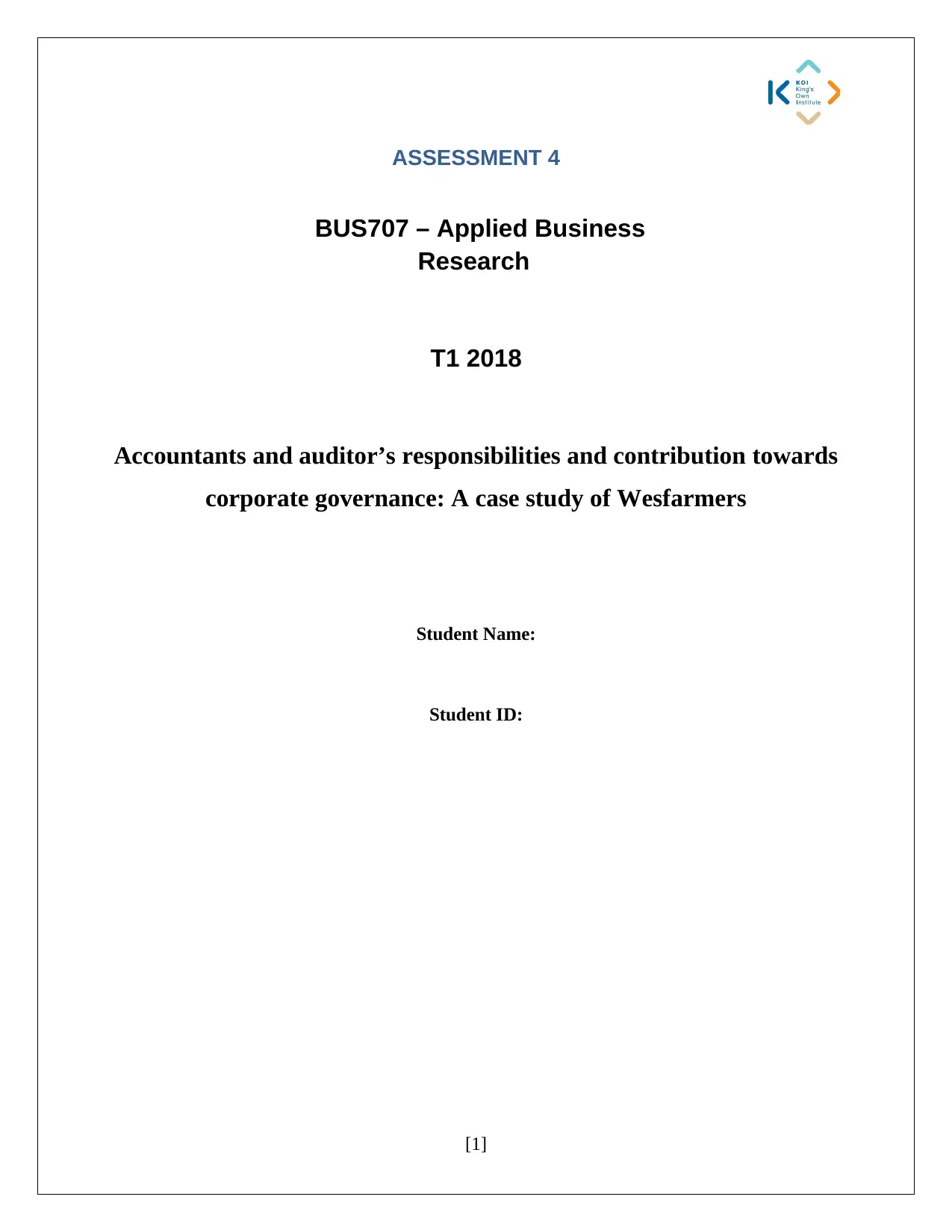
ASSESSMENT 4
BUS707 – Applied Business
Research
T1 2018
Accountants and auditor’s responsibilities and contribution towards
corporate governance: A case study of Wesfarmers
Student Name:
Student ID:
[1]
BUS707 – Applied Business
Research
T1 2018
Accountants and auditor’s responsibilities and contribution towards
corporate governance: A case study of Wesfarmers
Student Name:
Student ID:
[1]
Paraphrase This Document
Need a fresh take? Get an instant paraphrase of this document with our AI Paraphraser
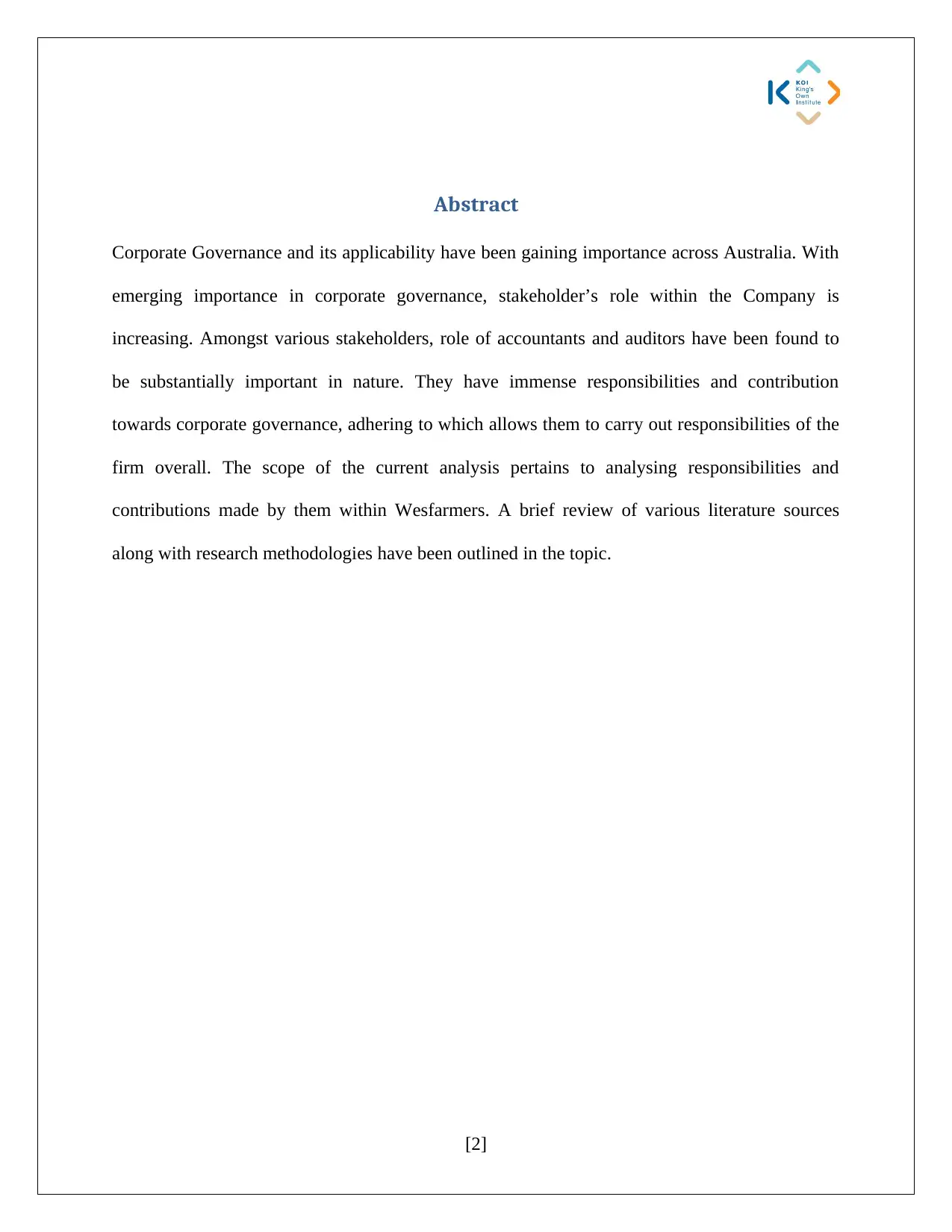
Abstract
Corporate Governance and its applicability have been gaining importance across Australia. With
emerging importance in corporate governance, stakeholder’s role within the Company is
increasing. Amongst various stakeholders, role of accountants and auditors have been found to
be substantially important in nature. They have immense responsibilities and contribution
towards corporate governance, adhering to which allows them to carry out responsibilities of the
firm overall. The scope of the current analysis pertains to analysing responsibilities and
contributions made by them within Wesfarmers. A brief review of various literature sources
along with research methodologies have been outlined in the topic.
[2]
Corporate Governance and its applicability have been gaining importance across Australia. With
emerging importance in corporate governance, stakeholder’s role within the Company is
increasing. Amongst various stakeholders, role of accountants and auditors have been found to
be substantially important in nature. They have immense responsibilities and contribution
towards corporate governance, adhering to which allows them to carry out responsibilities of the
firm overall. The scope of the current analysis pertains to analysing responsibilities and
contributions made by them within Wesfarmers. A brief review of various literature sources
along with research methodologies have been outlined in the topic.
[2]
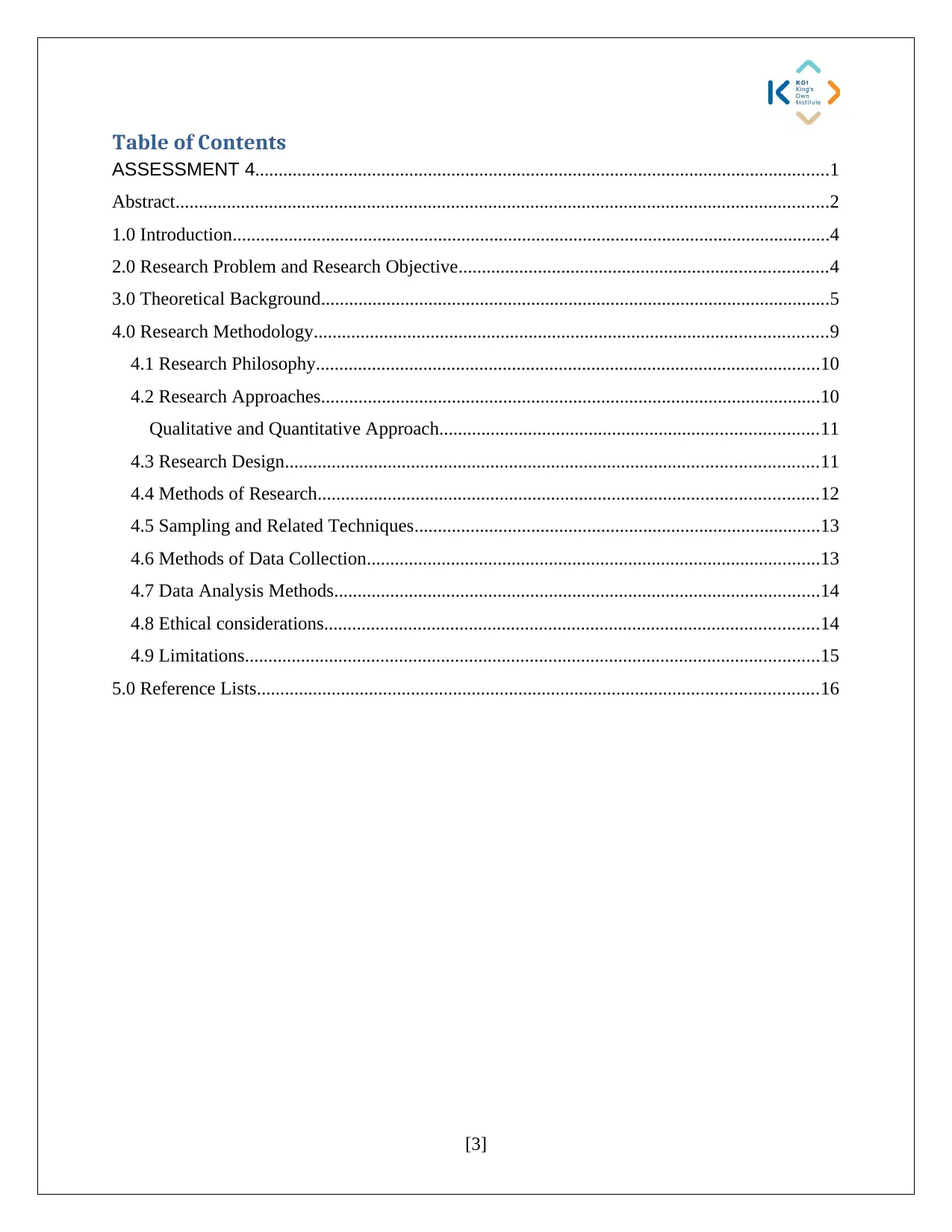
Table of Contents
ASSESSMENT 4...........................................................................................................................1
Abstract............................................................................................................................................2
1.0 Introduction................................................................................................................................4
2.0 Research Problem and Research Objective...............................................................................4
3.0 Theoretical Background.............................................................................................................5
4.0 Research Methodology..............................................................................................................9
4.1 Research Philosophy............................................................................................................10
4.2 Research Approaches...........................................................................................................10
Qualitative and Quantitative Approach.................................................................................11
4.3 Research Design..................................................................................................................11
4.4 Methods of Research...........................................................................................................12
4.5 Sampling and Related Techniques.......................................................................................13
4.6 Methods of Data Collection.................................................................................................13
4.7 Data Analysis Methods........................................................................................................14
4.8 Ethical considerations..........................................................................................................14
4.9 Limitations...........................................................................................................................15
5.0 Reference Lists........................................................................................................................16
[3]
ASSESSMENT 4...........................................................................................................................1
Abstract............................................................................................................................................2
1.0 Introduction................................................................................................................................4
2.0 Research Problem and Research Objective...............................................................................4
3.0 Theoretical Background.............................................................................................................5
4.0 Research Methodology..............................................................................................................9
4.1 Research Philosophy............................................................................................................10
4.2 Research Approaches...........................................................................................................10
Qualitative and Quantitative Approach.................................................................................11
4.3 Research Design..................................................................................................................11
4.4 Methods of Research...........................................................................................................12
4.5 Sampling and Related Techniques.......................................................................................13
4.6 Methods of Data Collection.................................................................................................13
4.7 Data Analysis Methods........................................................................................................14
4.8 Ethical considerations..........................................................................................................14
4.9 Limitations...........................................................................................................................15
5.0 Reference Lists........................................................................................................................16
[3]
⊘ This is a preview!⊘
Do you want full access?
Subscribe today to unlock all pages.

Trusted by 1+ million students worldwide
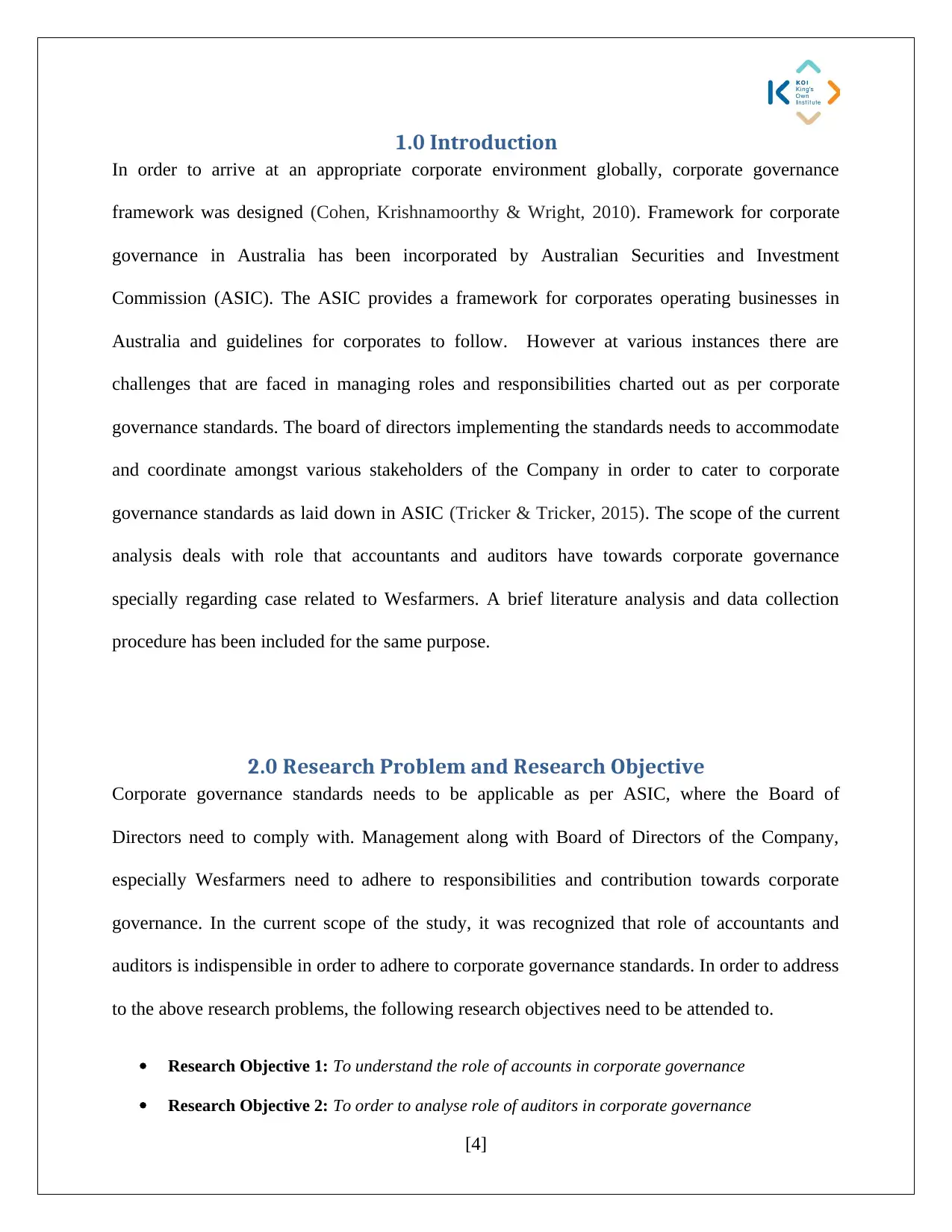
1.0 Introduction
In order to arrive at an appropriate corporate environment globally, corporate governance
framework was designed (Cohen, Krishnamoorthy & Wright, 2010). Framework for corporate
governance in Australia has been incorporated by Australian Securities and Investment
Commission (ASIC). The ASIC provides a framework for corporates operating businesses in
Australia and guidelines for corporates to follow. However at various instances there are
challenges that are faced in managing roles and responsibilities charted out as per corporate
governance standards. The board of directors implementing the standards needs to accommodate
and coordinate amongst various stakeholders of the Company in order to cater to corporate
governance standards as laid down in ASIC (Tricker & Tricker, 2015). The scope of the current
analysis deals with role that accountants and auditors have towards corporate governance
specially regarding case related to Wesfarmers. A brief literature analysis and data collection
procedure has been included for the same purpose.
2.0 Research Problem and Research Objective
Corporate governance standards needs to be applicable as per ASIC, where the Board of
Directors need to comply with. Management along with Board of Directors of the Company,
especially Wesfarmers need to adhere to responsibilities and contribution towards corporate
governance. In the current scope of the study, it was recognized that role of accountants and
auditors is indispensible in order to adhere to corporate governance standards. In order to address
to the above research problems, the following research objectives need to be attended to.
Research Objective 1: To understand the role of accounts in corporate governance
Research Objective 2: To order to analyse role of auditors in corporate governance
[4]
In order to arrive at an appropriate corporate environment globally, corporate governance
framework was designed (Cohen, Krishnamoorthy & Wright, 2010). Framework for corporate
governance in Australia has been incorporated by Australian Securities and Investment
Commission (ASIC). The ASIC provides a framework for corporates operating businesses in
Australia and guidelines for corporates to follow. However at various instances there are
challenges that are faced in managing roles and responsibilities charted out as per corporate
governance standards. The board of directors implementing the standards needs to accommodate
and coordinate amongst various stakeholders of the Company in order to cater to corporate
governance standards as laid down in ASIC (Tricker & Tricker, 2015). The scope of the current
analysis deals with role that accountants and auditors have towards corporate governance
specially regarding case related to Wesfarmers. A brief literature analysis and data collection
procedure has been included for the same purpose.
2.0 Research Problem and Research Objective
Corporate governance standards needs to be applicable as per ASIC, where the Board of
Directors need to comply with. Management along with Board of Directors of the Company,
especially Wesfarmers need to adhere to responsibilities and contribution towards corporate
governance. In the current scope of the study, it was recognized that role of accountants and
auditors is indispensible in order to adhere to corporate governance standards. In order to address
to the above research problems, the following research objectives need to be attended to.
Research Objective 1: To understand the role of accounts in corporate governance
Research Objective 2: To order to analyse role of auditors in corporate governance
[4]
Paraphrase This Document
Need a fresh take? Get an instant paraphrase of this document with our AI Paraphraser
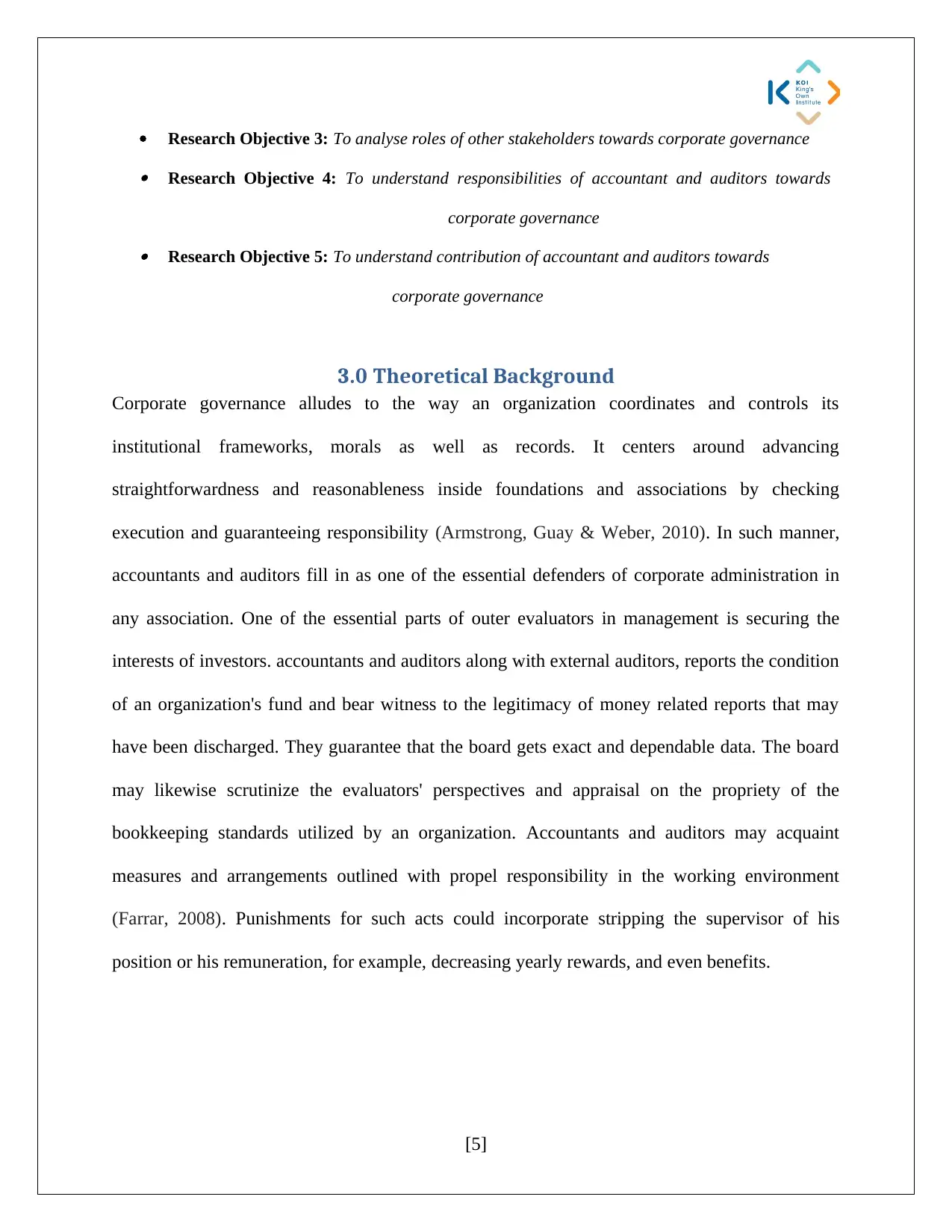
Research Objective 3: To analyse roles of other stakeholders towards corporate governance Research Objective 4: To understand responsibilities of accountant and auditors towards
corporate governance Research Objective 5: To understand contribution of accountant and auditors towards
corporate governance
3.0 Theoretical Background
Corporate governance alludes to the way an organization coordinates and controls its
institutional frameworks, morals as well as records. It centers around advancing
straightforwardness and reasonableness inside foundations and associations by checking
execution and guaranteeing responsibility (Armstrong, Guay & Weber, 2010). In such manner,
accountants and auditors fill in as one of the essential defenders of corporate administration in
any association. One of the essential parts of outer evaluators in management is securing the
interests of investors. accountants and auditors along with external auditors, reports the condition
of an organization's fund and bear witness to the legitimacy of money related reports that may
have been discharged. They guarantee that the board gets exact and dependable data. The board
may likewise scrutinize the evaluators' perspectives and appraisal on the propriety of the
bookkeeping standards utilized by an organization. Accountants and auditors may acquaint
measures and arrangements outlined with propel responsibility in the working environment
(Farrar, 2008). Punishments for such acts could incorporate stripping the supervisor of his
position or his remuneration, for example, decreasing yearly rewards, and even benefits.
[5]
corporate governance Research Objective 5: To understand contribution of accountant and auditors towards
corporate governance
3.0 Theoretical Background
Corporate governance alludes to the way an organization coordinates and controls its
institutional frameworks, morals as well as records. It centers around advancing
straightforwardness and reasonableness inside foundations and associations by checking
execution and guaranteeing responsibility (Armstrong, Guay & Weber, 2010). In such manner,
accountants and auditors fill in as one of the essential defenders of corporate administration in
any association. One of the essential parts of outer evaluators in management is securing the
interests of investors. accountants and auditors along with external auditors, reports the condition
of an organization's fund and bear witness to the legitimacy of money related reports that may
have been discharged. They guarantee that the board gets exact and dependable data. The board
may likewise scrutinize the evaluators' perspectives and appraisal on the propriety of the
bookkeeping standards utilized by an organization. Accountants and auditors may acquaint
measures and arrangements outlined with propel responsibility in the working environment
(Farrar, 2008). Punishments for such acts could incorporate stripping the supervisor of his
position or his remuneration, for example, decreasing yearly rewards, and even benefits.
[5]
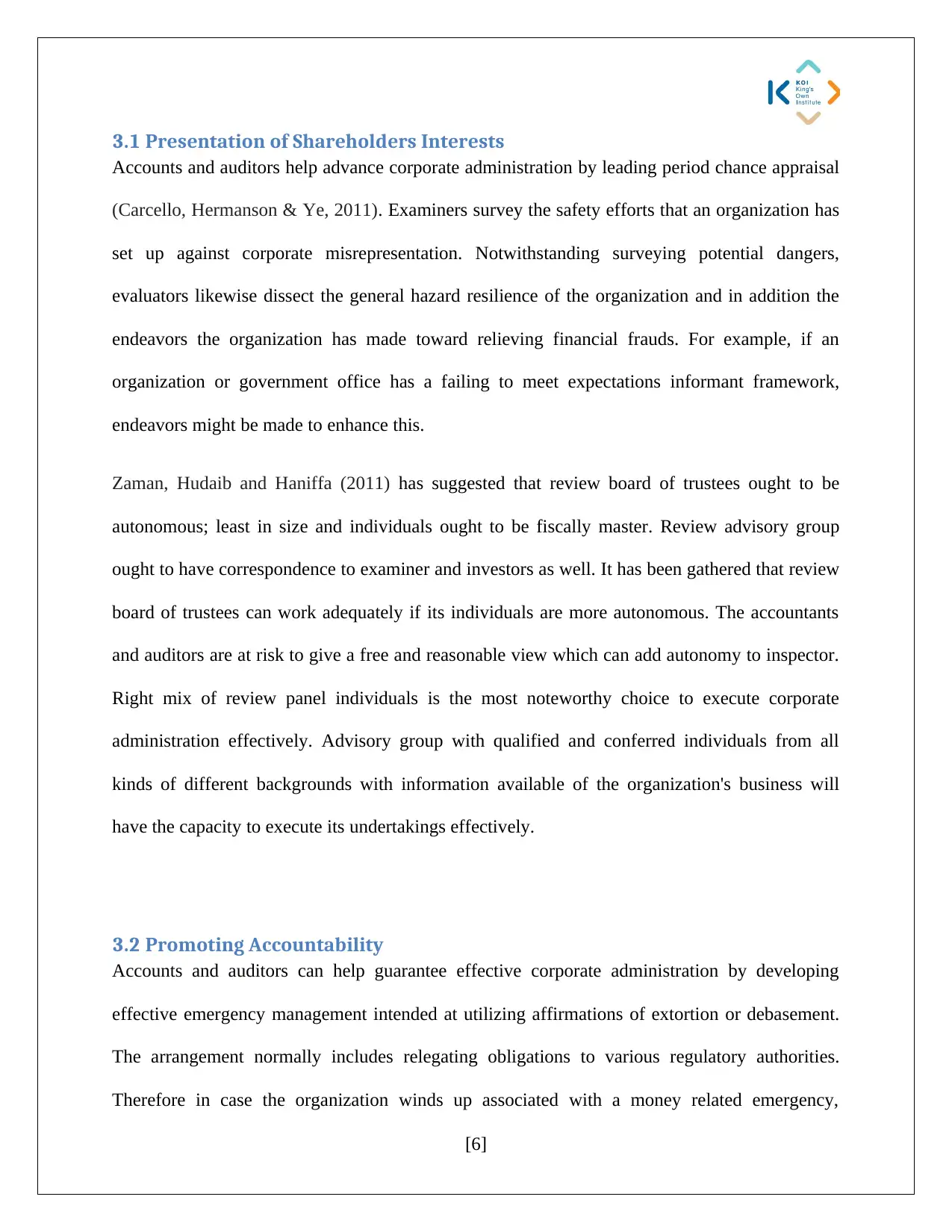
3.1 Presentation of Shareholders Interests
Accounts and auditors help advance corporate administration by leading period chance appraisal
(Carcello, Hermanson & Ye, 2011). Examiners survey the safety efforts that an organization has
set up against corporate misrepresentation. Notwithstanding surveying potential dangers,
evaluators likewise dissect the general hazard resilience of the organization and in addition the
endeavors the organization has made toward relieving financial frauds. For example, if an
organization or government office has a failing to meet expectations informant framework,
endeavors might be made to enhance this.
Zaman, Hudaib and Haniffa (2011) has suggested that review board of trustees ought to be
autonomous; least in size and individuals ought to be fiscally master. Review advisory group
ought to have correspondence to examiner and investors as well. It has been gathered that review
board of trustees can work adequately if its individuals are more autonomous. The accountants
and auditors are at risk to give a free and reasonable view which can add autonomy to inspector.
Right mix of review panel individuals is the most noteworthy choice to execute corporate
administration effectively. Advisory group with qualified and conferred individuals from all
kinds of different backgrounds with information available of the organization's business will
have the capacity to execute its undertakings effectively.
3.2 Promoting Accountability
Accounts and auditors can help guarantee effective corporate administration by developing
effective emergency management intended at utilizing affirmations of extortion or debasement.
The arrangement normally includes relegating obligations to various regulatory authorities.
Therefore in case the organization winds up associated with a money related emergency,
[6]
Accounts and auditors help advance corporate administration by leading period chance appraisal
(Carcello, Hermanson & Ye, 2011). Examiners survey the safety efforts that an organization has
set up against corporate misrepresentation. Notwithstanding surveying potential dangers,
evaluators likewise dissect the general hazard resilience of the organization and in addition the
endeavors the organization has made toward relieving financial frauds. For example, if an
organization or government office has a failing to meet expectations informant framework,
endeavors might be made to enhance this.
Zaman, Hudaib and Haniffa (2011) has suggested that review board of trustees ought to be
autonomous; least in size and individuals ought to be fiscally master. Review advisory group
ought to have correspondence to examiner and investors as well. It has been gathered that review
board of trustees can work adequately if its individuals are more autonomous. The accountants
and auditors are at risk to give a free and reasonable view which can add autonomy to inspector.
Right mix of review panel individuals is the most noteworthy choice to execute corporate
administration effectively. Advisory group with qualified and conferred individuals from all
kinds of different backgrounds with information available of the organization's business will
have the capacity to execute its undertakings effectively.
3.2 Promoting Accountability
Accounts and auditors can help guarantee effective corporate administration by developing
effective emergency management intended at utilizing affirmations of extortion or debasement.
The arrangement normally includes relegating obligations to various regulatory authorities.
Therefore in case the organization winds up associated with a money related emergency,
[6]
⊘ This is a preview!⊘
Do you want full access?
Subscribe today to unlock all pages.

Trusted by 1+ million students worldwide
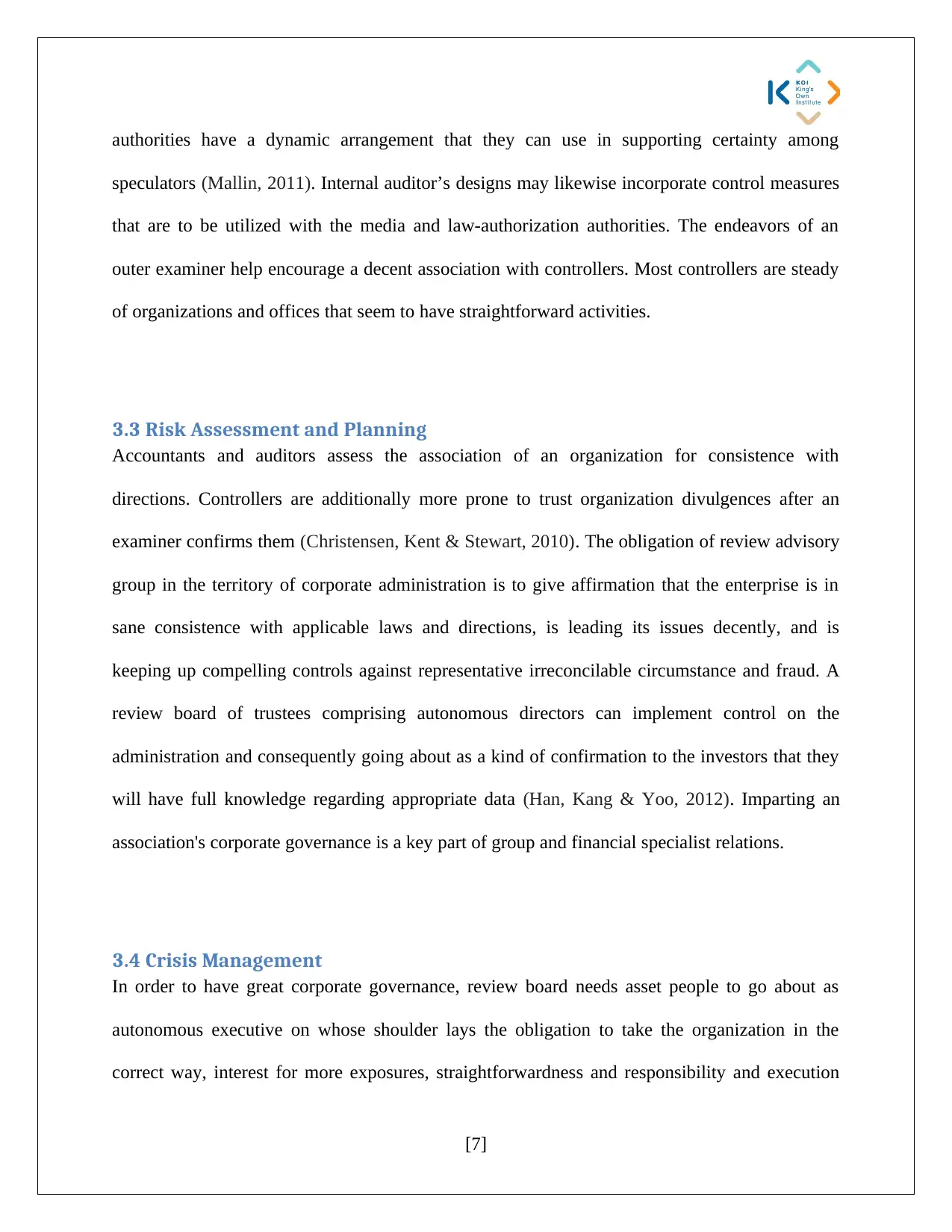
authorities have a dynamic arrangement that they can use in supporting certainty among
speculators (Mallin, 2011). Internal auditor’s designs may likewise incorporate control measures
that are to be utilized with the media and law-authorization authorities. The endeavors of an
outer examiner help encourage a decent association with controllers. Most controllers are steady
of organizations and offices that seem to have straightforward activities.
3.3 Risk Assessment and Planning
Accountants and auditors assess the association of an organization for consistence with
directions. Controllers are additionally more prone to trust organization divulgences after an
examiner confirms them (Christensen, Kent & Stewart, 2010). The obligation of review advisory
group in the territory of corporate administration is to give affirmation that the enterprise is in
sane consistence with applicable laws and directions, is leading its issues decently, and is
keeping up compelling controls against representative irreconcilable circumstance and fraud. A
review board of trustees comprising autonomous directors can implement control on the
administration and consequently going about as a kind of confirmation to the investors that they
will have full knowledge regarding appropriate data (Han, Kang & Yoo, 2012). Imparting an
association's corporate governance is a key part of group and financial specialist relations.
3.4 Crisis Management
In order to have great corporate governance, review board needs asset people to go about as
autonomous executive on whose shoulder lays the obligation to take the organization in the
correct way, interest for more exposures, straightforwardness and responsibility and execution
[7]
speculators (Mallin, 2011). Internal auditor’s designs may likewise incorporate control measures
that are to be utilized with the media and law-authorization authorities. The endeavors of an
outer examiner help encourage a decent association with controllers. Most controllers are steady
of organizations and offices that seem to have straightforward activities.
3.3 Risk Assessment and Planning
Accountants and auditors assess the association of an organization for consistence with
directions. Controllers are additionally more prone to trust organization divulgences after an
examiner confirms them (Christensen, Kent & Stewart, 2010). The obligation of review advisory
group in the territory of corporate administration is to give affirmation that the enterprise is in
sane consistence with applicable laws and directions, is leading its issues decently, and is
keeping up compelling controls against representative irreconcilable circumstance and fraud. A
review board of trustees comprising autonomous directors can implement control on the
administration and consequently going about as a kind of confirmation to the investors that they
will have full knowledge regarding appropriate data (Han, Kang & Yoo, 2012). Imparting an
association's corporate governance is a key part of group and financial specialist relations.
3.4 Crisis Management
In order to have great corporate governance, review board needs asset people to go about as
autonomous executive on whose shoulder lays the obligation to take the organization in the
correct way, interest for more exposures, straightforwardness and responsibility and execution
[7]
Paraphrase This Document
Need a fresh take? Get an instant paraphrase of this document with our AI Paraphraser
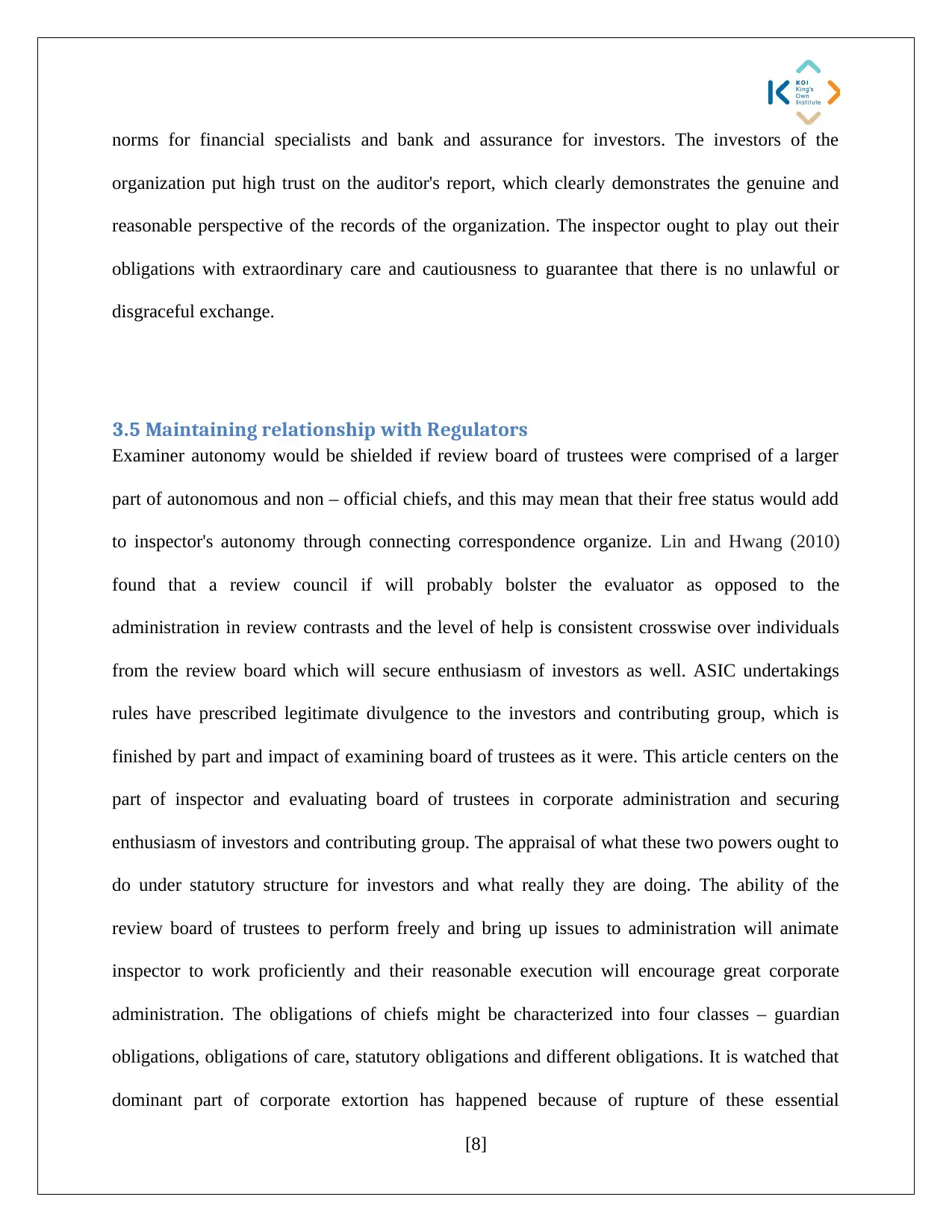
norms for financial specialists and bank and assurance for investors. The investors of the
organization put high trust on the auditor's report, which clearly demonstrates the genuine and
reasonable perspective of the records of the organization. The inspector ought to play out their
obligations with extraordinary care and cautiousness to guarantee that there is no unlawful or
disgraceful exchange.
3.5 Maintaining relationship with Regulators
Examiner autonomy would be shielded if review board of trustees were comprised of a larger
part of autonomous and non – official chiefs, and this may mean that their free status would add
to inspector's autonomy through connecting correspondence organize. Lin and Hwang (2010)
found that a review council if will probably bolster the evaluator as opposed to the
administration in review contrasts and the level of help is consistent crosswise over individuals
from the review board which will secure enthusiasm of investors as well. ASIC undertakings
rules have prescribed legitimate divulgence to the investors and contributing group, which is
finished by part and impact of examining board of trustees as it were. This article centers on the
part of inspector and evaluating board of trustees in corporate administration and securing
enthusiasm of investors and contributing group. The appraisal of what these two powers ought to
do under statutory structure for investors and what really they are doing. The ability of the
review board of trustees to perform freely and bring up issues to administration will animate
inspector to work proficiently and their reasonable execution will encourage great corporate
administration. The obligations of chiefs might be characterized into four classes – guardian
obligations, obligations of care, statutory obligations and different obligations. It is watched that
dominant part of corporate extortion has happened because of rupture of these essential
[8]
organization put high trust on the auditor's report, which clearly demonstrates the genuine and
reasonable perspective of the records of the organization. The inspector ought to play out their
obligations with extraordinary care and cautiousness to guarantee that there is no unlawful or
disgraceful exchange.
3.5 Maintaining relationship with Regulators
Examiner autonomy would be shielded if review board of trustees were comprised of a larger
part of autonomous and non – official chiefs, and this may mean that their free status would add
to inspector's autonomy through connecting correspondence organize. Lin and Hwang (2010)
found that a review council if will probably bolster the evaluator as opposed to the
administration in review contrasts and the level of help is consistent crosswise over individuals
from the review board which will secure enthusiasm of investors as well. ASIC undertakings
rules have prescribed legitimate divulgence to the investors and contributing group, which is
finished by part and impact of examining board of trustees as it were. This article centers on the
part of inspector and evaluating board of trustees in corporate administration and securing
enthusiasm of investors and contributing group. The appraisal of what these two powers ought to
do under statutory structure for investors and what really they are doing. The ability of the
review board of trustees to perform freely and bring up issues to administration will animate
inspector to work proficiently and their reasonable execution will encourage great corporate
administration. The obligations of chiefs might be characterized into four classes – guardian
obligations, obligations of care, statutory obligations and different obligations. It is watched that
dominant part of corporate extortion has happened because of rupture of these essential
[8]
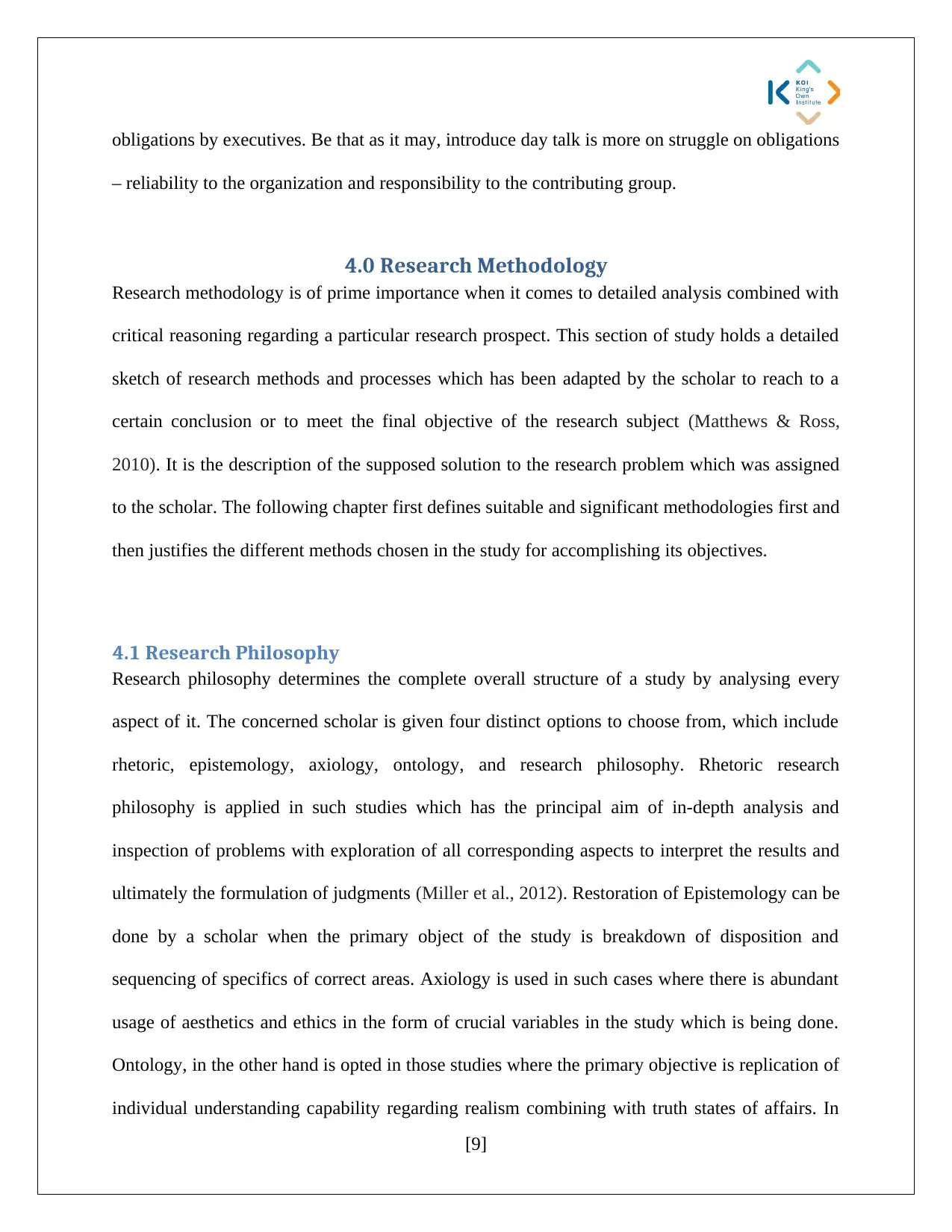
obligations by executives. Be that as it may, introduce day talk is more on struggle on obligations
– reliability to the organization and responsibility to the contributing group.
4.0 Research Methodology
Research methodology is of prime importance when it comes to detailed analysis combined with
critical reasoning regarding a particular research prospect. This section of study holds a detailed
sketch of research methods and processes which has been adapted by the scholar to reach to a
certain conclusion or to meet the final objective of the research subject (Matthews & Ross,
2010). It is the description of the supposed solution to the research problem which was assigned
to the scholar. The following chapter first defines suitable and significant methodologies first and
then justifies the different methods chosen in the study for accomplishing its objectives.
4.1 Research Philosophy
Research philosophy determines the complete overall structure of a study by analysing every
aspect of it. The concerned scholar is given four distinct options to choose from, which include
rhetoric, epistemology, axiology, ontology, and research philosophy. Rhetoric research
philosophy is applied in such studies which has the principal aim of in-depth analysis and
inspection of problems with exploration of all corresponding aspects to interpret the results and
ultimately the formulation of judgments (Miller et al., 2012). Restoration of Epistemology can be
done by a scholar when the primary object of the study is breakdown of disposition and
sequencing of specifics of correct areas. Axiology is used in such cases where there is abundant
usage of aesthetics and ethics in the form of crucial variables in the study which is being done.
Ontology, in the other hand is opted in those studies where the primary objective is replication of
individual understanding capability regarding realism combining with truth states of affairs. In
[9]
– reliability to the organization and responsibility to the contributing group.
4.0 Research Methodology
Research methodology is of prime importance when it comes to detailed analysis combined with
critical reasoning regarding a particular research prospect. This section of study holds a detailed
sketch of research methods and processes which has been adapted by the scholar to reach to a
certain conclusion or to meet the final objective of the research subject (Matthews & Ross,
2010). It is the description of the supposed solution to the research problem which was assigned
to the scholar. The following chapter first defines suitable and significant methodologies first and
then justifies the different methods chosen in the study for accomplishing its objectives.
4.1 Research Philosophy
Research philosophy determines the complete overall structure of a study by analysing every
aspect of it. The concerned scholar is given four distinct options to choose from, which include
rhetoric, epistemology, axiology, ontology, and research philosophy. Rhetoric research
philosophy is applied in such studies which has the principal aim of in-depth analysis and
inspection of problems with exploration of all corresponding aspects to interpret the results and
ultimately the formulation of judgments (Miller et al., 2012). Restoration of Epistemology can be
done by a scholar when the primary object of the study is breakdown of disposition and
sequencing of specifics of correct areas. Axiology is used in such cases where there is abundant
usage of aesthetics and ethics in the form of crucial variables in the study which is being done.
Ontology, in the other hand is opted in those studies where the primary objective is replication of
individual understanding capability regarding realism combining with truth states of affairs. In
[9]
⊘ This is a preview!⊘
Do you want full access?
Subscribe today to unlock all pages.

Trusted by 1+ million students worldwide
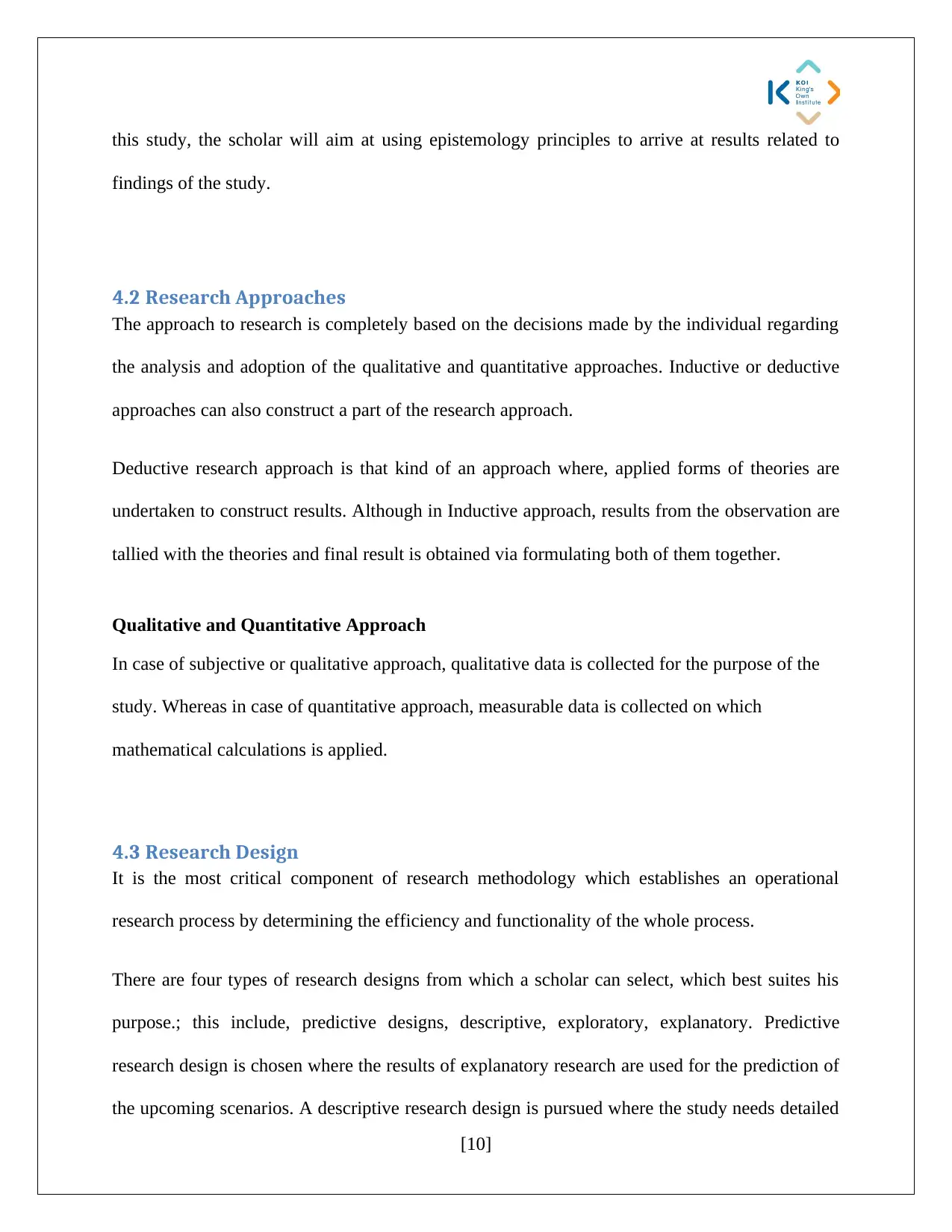
this study, the scholar will aim at using epistemology principles to arrive at results related to
findings of the study.
4.2 Research Approaches
The approach to research is completely based on the decisions made by the individual regarding
the analysis and adoption of the qualitative and quantitative approaches. Inductive or deductive
approaches can also construct a part of the research approach.
Deductive research approach is that kind of an approach where, applied forms of theories are
undertaken to construct results. Although in Inductive approach, results from the observation are
tallied with the theories and final result is obtained via formulating both of them together.
Qualitative and Quantitative Approach
In case of subjective or qualitative approach, qualitative data is collected for the purpose of the
study. Whereas in case of quantitative approach, measurable data is collected on which
mathematical calculations is applied.
4.3 Research Design
It is the most critical component of research methodology which establishes an operational
research process by determining the efficiency and functionality of the whole process.
There are four types of research designs from which a scholar can select, which best suites his
purpose.; this include, predictive designs, descriptive, exploratory, explanatory. Predictive
research design is chosen where the results of explanatory research are used for the prediction of
the upcoming scenarios. A descriptive research design is pursued where the study needs detailed
[10]
findings of the study.
4.2 Research Approaches
The approach to research is completely based on the decisions made by the individual regarding
the analysis and adoption of the qualitative and quantitative approaches. Inductive or deductive
approaches can also construct a part of the research approach.
Deductive research approach is that kind of an approach where, applied forms of theories are
undertaken to construct results. Although in Inductive approach, results from the observation are
tallied with the theories and final result is obtained via formulating both of them together.
Qualitative and Quantitative Approach
In case of subjective or qualitative approach, qualitative data is collected for the purpose of the
study. Whereas in case of quantitative approach, measurable data is collected on which
mathematical calculations is applied.
4.3 Research Design
It is the most critical component of research methodology which establishes an operational
research process by determining the efficiency and functionality of the whole process.
There are four types of research designs from which a scholar can select, which best suites his
purpose.; this include, predictive designs, descriptive, exploratory, explanatory. Predictive
research design is chosen where the results of explanatory research are used for the prediction of
the upcoming scenarios. A descriptive research design is pursued where the study needs detailed
[10]
Paraphrase This Document
Need a fresh take? Get an instant paraphrase of this document with our AI Paraphraser
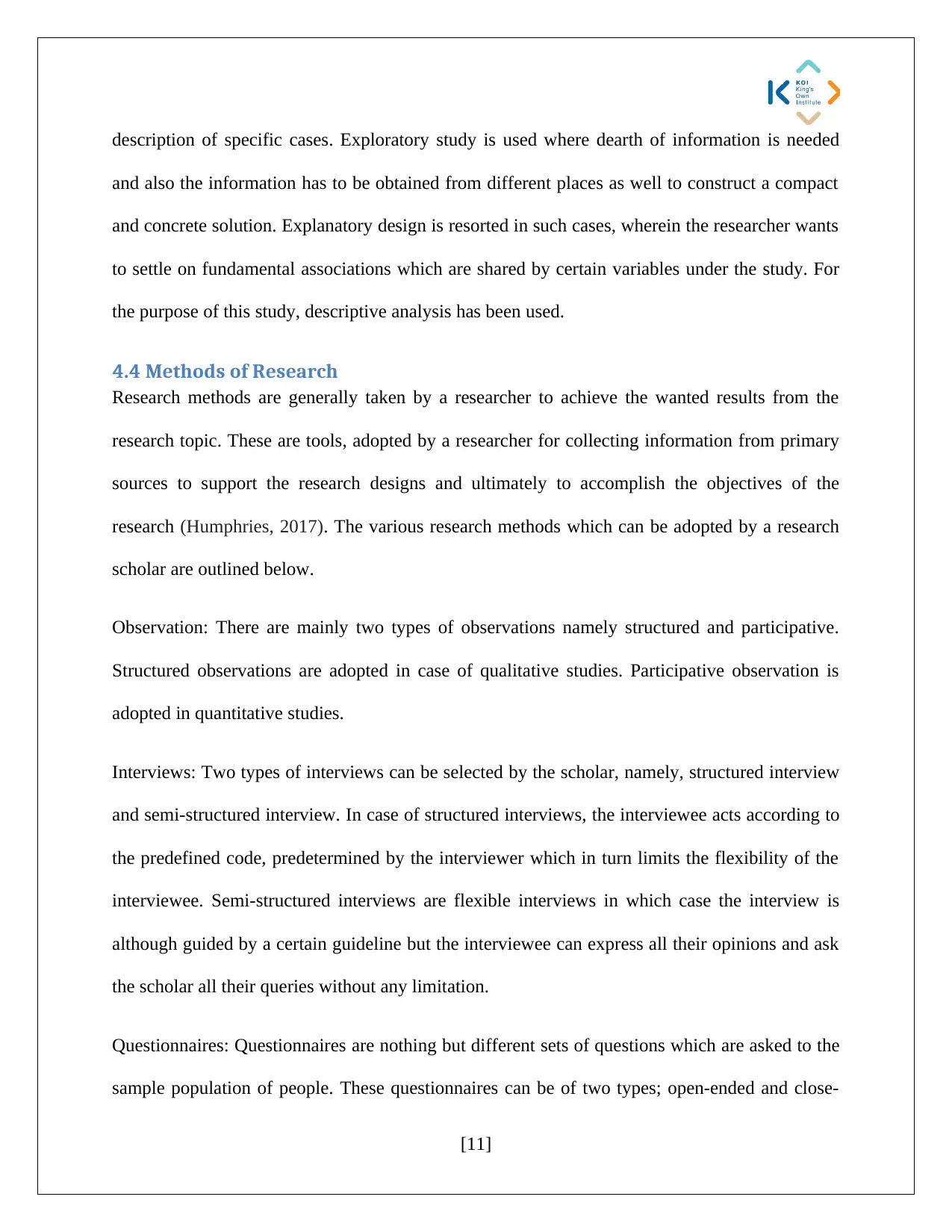
description of specific cases. Exploratory study is used where dearth of information is needed
and also the information has to be obtained from different places as well to construct a compact
and concrete solution. Explanatory design is resorted in such cases, wherein the researcher wants
to settle on fundamental associations which are shared by certain variables under the study. For
the purpose of this study, descriptive analysis has been used.
4.4 Methods of Research
Research methods are generally taken by a researcher to achieve the wanted results from the
research topic. These are tools, adopted by a researcher for collecting information from primary
sources to support the research designs and ultimately to accomplish the objectives of the
research (Humphries, 2017). The various research methods which can be adopted by a research
scholar are outlined below.
Observation: There are mainly two types of observations namely structured and participative.
Structured observations are adopted in case of qualitative studies. Participative observation is
adopted in quantitative studies.
Interviews: Two types of interviews can be selected by the scholar, namely, structured interview
and semi-structured interview. In case of structured interviews, the interviewee acts according to
the predefined code, predetermined by the interviewer which in turn limits the flexibility of the
interviewee. Semi-structured interviews are flexible interviews in which case the interview is
although guided by a certain guideline but the interviewee can express all their opinions and ask
the scholar all their queries without any limitation.
Questionnaires: Questionnaires are nothing but different sets of questions which are asked to the
sample population of people. These questionnaires can be of two types; open-ended and close-
[11]
and also the information has to be obtained from different places as well to construct a compact
and concrete solution. Explanatory design is resorted in such cases, wherein the researcher wants
to settle on fundamental associations which are shared by certain variables under the study. For
the purpose of this study, descriptive analysis has been used.
4.4 Methods of Research
Research methods are generally taken by a researcher to achieve the wanted results from the
research topic. These are tools, adopted by a researcher for collecting information from primary
sources to support the research designs and ultimately to accomplish the objectives of the
research (Humphries, 2017). The various research methods which can be adopted by a research
scholar are outlined below.
Observation: There are mainly two types of observations namely structured and participative.
Structured observations are adopted in case of qualitative studies. Participative observation is
adopted in quantitative studies.
Interviews: Two types of interviews can be selected by the scholar, namely, structured interview
and semi-structured interview. In case of structured interviews, the interviewee acts according to
the predefined code, predetermined by the interviewer which in turn limits the flexibility of the
interviewee. Semi-structured interviews are flexible interviews in which case the interview is
although guided by a certain guideline but the interviewee can express all their opinions and ask
the scholar all their queries without any limitation.
Questionnaires: Questionnaires are nothing but different sets of questions which are asked to the
sample population of people. These questionnaires can be of two types; open-ended and close-
[11]
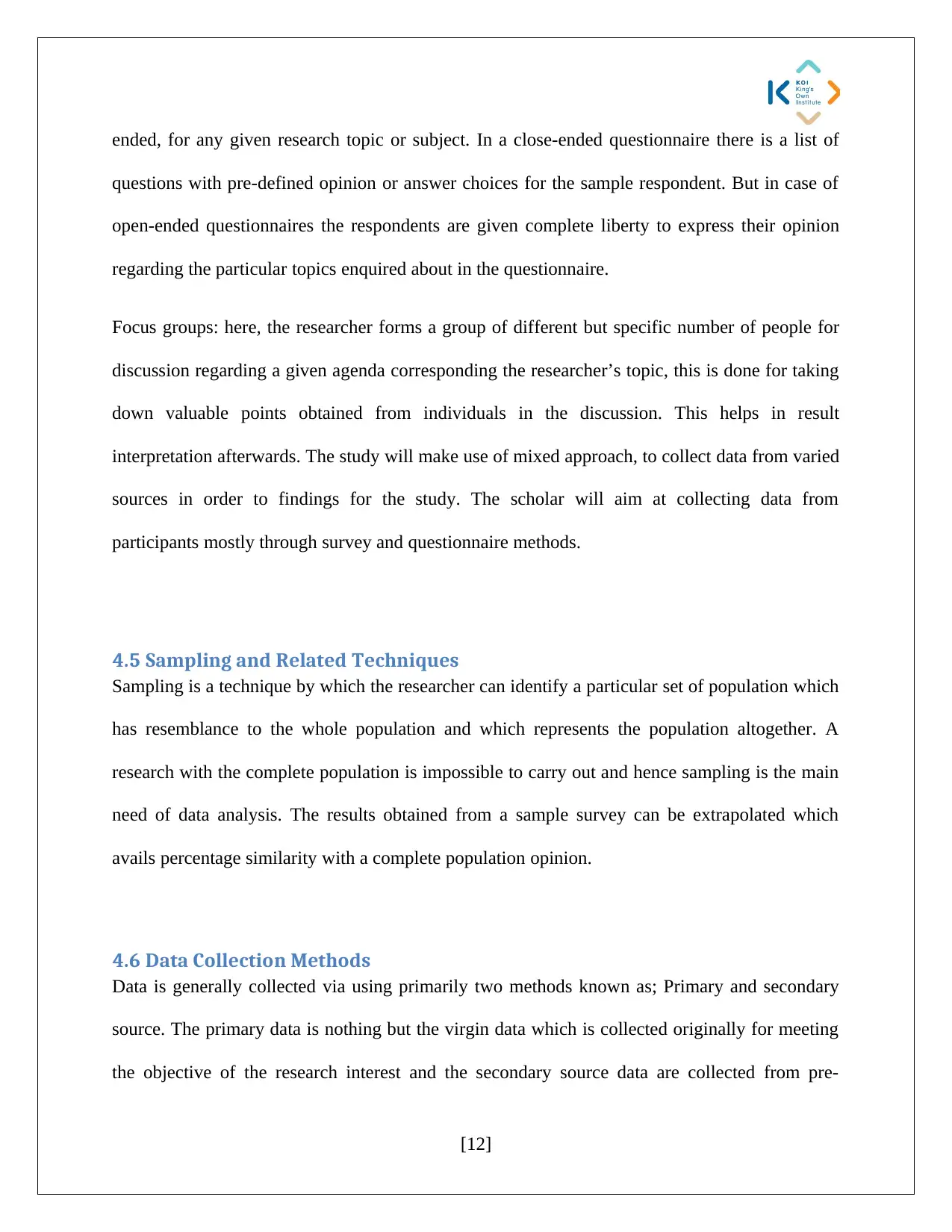
ended, for any given research topic or subject. In a close-ended questionnaire there is a list of
questions with pre-defined opinion or answer choices for the sample respondent. But in case of
open-ended questionnaires the respondents are given complete liberty to express their opinion
regarding the particular topics enquired about in the questionnaire.
Focus groups: here, the researcher forms a group of different but specific number of people for
discussion regarding a given agenda corresponding the researcher’s topic, this is done for taking
down valuable points obtained from individuals in the discussion. This helps in result
interpretation afterwards. The study will make use of mixed approach, to collect data from varied
sources in order to findings for the study. The scholar will aim at collecting data from
participants mostly through survey and questionnaire methods.
4.5 Sampling and Related Techniques
Sampling is a technique by which the researcher can identify a particular set of population which
has resemblance to the whole population and which represents the population altogether. A
research with the complete population is impossible to carry out and hence sampling is the main
need of data analysis. The results obtained from a sample survey can be extrapolated which
avails percentage similarity with a complete population opinion.
4.6 Data Collection Methods
Data is generally collected via using primarily two methods known as; Primary and secondary
source. The primary data is nothing but the virgin data which is collected originally for meeting
the objective of the research interest and the secondary source data are collected from pre-
[12]
questions with pre-defined opinion or answer choices for the sample respondent. But in case of
open-ended questionnaires the respondents are given complete liberty to express their opinion
regarding the particular topics enquired about in the questionnaire.
Focus groups: here, the researcher forms a group of different but specific number of people for
discussion regarding a given agenda corresponding the researcher’s topic, this is done for taking
down valuable points obtained from individuals in the discussion. This helps in result
interpretation afterwards. The study will make use of mixed approach, to collect data from varied
sources in order to findings for the study. The scholar will aim at collecting data from
participants mostly through survey and questionnaire methods.
4.5 Sampling and Related Techniques
Sampling is a technique by which the researcher can identify a particular set of population which
has resemblance to the whole population and which represents the population altogether. A
research with the complete population is impossible to carry out and hence sampling is the main
need of data analysis. The results obtained from a sample survey can be extrapolated which
avails percentage similarity with a complete population opinion.
4.6 Data Collection Methods
Data is generally collected via using primarily two methods known as; Primary and secondary
source. The primary data is nothing but the virgin data which is collected originally for meeting
the objective of the research interest and the secondary source data are collected from pre-
[12]
⊘ This is a preview!⊘
Do you want full access?
Subscribe today to unlock all pages.

Trusted by 1+ million students worldwide
1 out of 18
Related Documents
Your All-in-One AI-Powered Toolkit for Academic Success.
+13062052269
info@desklib.com
Available 24*7 on WhatsApp / Email
![[object Object]](/_next/static/media/star-bottom.7253800d.svg)
Unlock your academic potential
Copyright © 2020–2025 A2Z Services. All Rights Reserved. Developed and managed by ZUCOL.



